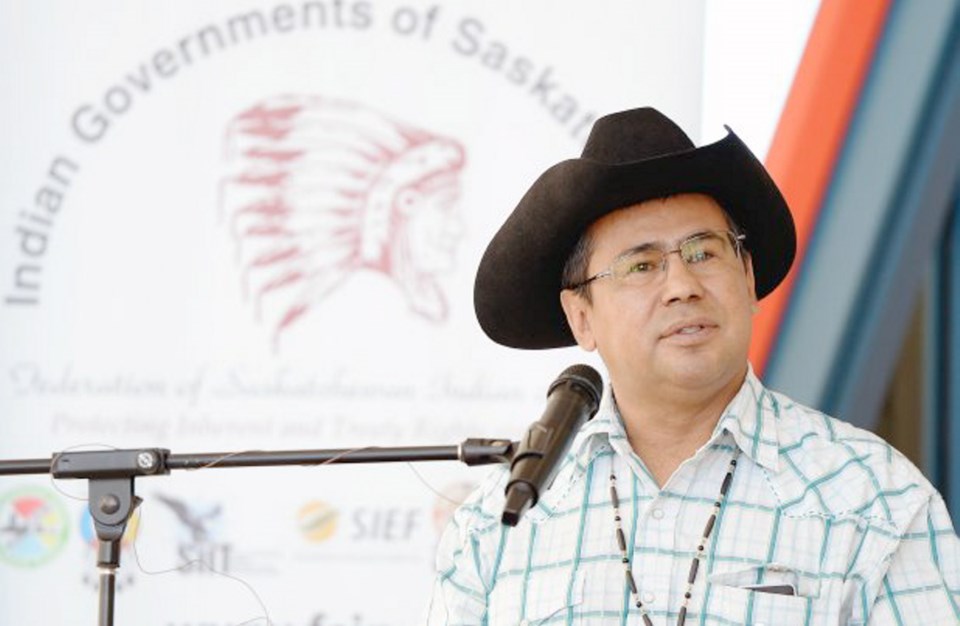OTTAWA ŌĆö The Supreme Court of Canada, in the most important aboriginal rights case in the nationŌĆÖs history, ruled that the TsilhqotŌĆÖin First Nation has title to ŌĆö or owns ŌĆö 1,750 square kilometres of land in south central B.C.
The landmark ruling will provide a clear and less onerous roadmap for all unresolved land claims in B.C. and throughout Canada involving First Nations seeking to negotiate modern treaties ŌĆō or to fight for their land rights in court.
The decision was immediately portrayed by aboriginal leaders as the mark of an epic shift in Canada-First Nations relations.
ŌĆ£This decision is a game-changer. The court has clearly sent a message that the Crown must take Aboriginal title seriously and reconcile with First Nations honourably,ŌĆØ said Jody Wilson-Raybould.
ŌĆ£The decision is an opportunity to truly settle, once and for all, the land question in B.C. ŌĆö where our Nations are not simply making claims to the Crown under an outdated federal policy but where there must be true reconciliation based on recognition and where the outcome of negotiations is certain.ŌĆØ
The unanimous ruling from all eight judges was written by Chief Justice Beverley McLachin.
ŌĆ£Aboriginal title confers the right to use and control the land and to reap the benefits flowing from it,ŌĆØ she stated in her ruling.
The decision largely accepted the broad interpretation of what title means, as laid out by the late Justice David Vickers in a 2007 B.C. Supreme Court decision, and rejected the far more narrow view delivered by the B.C. Court of Appeal in 2012.
Business groups have warned of ŌĆ£havocŌĆØ if the 2007 ruling prevailed, while First Nations said endorsement of the 2012 view would have made a mockery of the notion of Aboriginal title.
To be known for generations to come as the William case, after plaintiff Roger William, the decision confirmed for the first time any where in Canada a title claim.
But it also declared that provincial governments ŌĆö and not Ottawa, as some business groups had feared -- will retain regulatory authority over land obtained aboriginal people through court cases or land claim negotiations.
In B.C.ŌĆÖs case, due to a technicality, the provincial forests act will have to be amended in order to maintain that authority.
Future economic activity on title lands, involving anything from mines and logging to pipelines and hydroelectric projects, will require the ŌĆ£consentŌĆØ of title-holding First Nations.
But the court also said the Crown can justify ŌĆ£infringementŌĆØ of that title, when consent is absent, under specific circumstances.
ŌĆ£Government incursions not consented to by the title-holding group must be undertaken in accordance with the CrownŌĆÖs procedural duty to consult and must also be justified on the basis of a compelling and substantial public interest, and must be consistent with the CrownŌĆÖs fiduciary duty to the Aboriginal group,ŌĆØ the chief justice stated in her ruling.
The wording is crucial to the future of projects like EnbridgeŌĆÖs proposed Northern Gateway oilsands pipeline, which runs through claimed ŌĆö though not established as being title lands in court or through negotiations ŌĆö traditional territory of numerous First Nations.
Legal analysts have said a ruling such as ThursdayŌĆÖs would significantly strengthen the hand of First Nations in B.C. or Alberta who want to file a land claim on territory along the Gateway route, and hope to obtain an injunction preventing construction while that claim is heard.
ŌĆ£We take this time to join hands and celebrate a new relationship with Canada,ŌĆØ said the plaintiff, Chief Roger William of the Xeni GwetŌĆÖin people, who are one of six Indian Act bands that are part of the TsilhqotŌĆÖin First Nation.
Chief Joe Alphonse, tribal chairman of the TsilhqotŌĆÖin National Government, urged governments and industry to work with his people.
ŌĆ£This decision will bring much needed certainty for First Nations, government and industry,ŌĆØ he said in a statement.
ŌĆ£This case is about us regaining our independence ŌĆö to be able to govern our own Nation and rely on the natural resources of our land. We are ready to move forward in this new relationship with government and industry. That work starts todayŌĆØ
Grand Chief Stewart Phillip, president of the Union of B.C. Indian Chiefs, called the decision ŌĆ£absolutely amazing!ŌĆØ in the joint statement with the TsilhqotŌĆÖin leaders.
The judgment, because it was dealing with a semi-nomadic people who only seasonally occupied many parts of the claimed territory, established a less onerous test to establish title.
The 2012 ruling declared that title required proof of intensive, site-specific use that was sufficient, exclusive and had some semblance of continuity from the time British sovereignty was established ŌĆö in B.C. it was 1846 ŌĆö to the present day.
But ThursdayŌĆÖs ruling recognized a more flexible test than that spelled out by the three B.C. appellate judges. It also explained in greater detain than in past cases how judges and negotiators should in the future marry the differing perspectives of Aboriginal and common laws.
ŌĆ£Rather, a culturally sensitive approach suggests that regular use of territories for hunting, fishing, trapping and foraging is ŌĆśsufficientŌĆÖ use to ground Aboriginal title, provided that such use, on the facts of a particular case, evinces an intention on the part of the Aboriginal group to hold or possess the land in a manner comparable to what would be required to establish title at common law.ŌĆØ
The TsilhqotŌĆÖin First Nation is made up of six Indian Act bands. The trial, which began in 2002, lasted 339 days and included a visit by Judge Vickers to the claimed territory.
The case involved provincial forestry licenses that were granted in the claimed territory.
Justice McLachlin found that the province ŌĆö which argued that the licenses should be granted due to economic need as well as because of the requirement to attack the Mountain Pine Beetle infestation - hadnŌĆÖt met the ŌĆ£compelling and substantialŌĆØ test.
╠²



